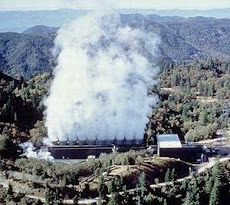An Old But Interesting (Regan Era) Article by the good folks at the CATO Institute; here we will learn some new and strange sounding words like title by "usus" or "usufructuary rights" of ranchers, "fee simple" and "arms length" sales are examples......
Posting this article is by no means an endorsement of the mindset expoused by the authors that "privatization of public lands" is the way to go. I am not so sure about that....there has to be a "happy (and fair") median in all things, which is certainly NOT what we have now with the underhanded, secretive and dirty dealings of the Various Departments of the Inferior, ooops I mean Interior. Goodness me, I didnt mean to goof.(Yeah, right) Take That! U Greedi Ba$T@rD$! Give up your grazing permits and give the land back to the people of the USA. Give the land back to the horses! Your Rancher Welfare programs are costing billions of dollars each year that the tax payers have to pay. Talk about "ear-marks," the BLM is nothing but one big one for whomever is holding those grazing permits.
*Interesting and related factoid: FY 2010 budget appropriates over 120 Bil to Ag. Dont think the "favored sons" ranchers wont get a BIG chunk a' dat..
Read on, my friends, and weep.
PRIVATIZATION, JUSTICE AND MARKETS
Richard Auster;CatoJournal, Vol. 3, No. 3 (Winter 1983/84).
The author is Associate Professor of Economics at the University ofArizona, Tucson,Az.
---------------------
As the gains from privatization necessarily increase with the density
of usage of the commons, it is quite natural that we find the movement
to privatize public land holdings emerging, Privatization is both
natural and correct and it is in no way the purpose of this paper to
argue against it, Private ownership is clearly a more efficient method
of controlling the usage of our now public lands, Efficiency is not the
only issue, however, There is also the issue of equity, of preventing
in-justice and theft. That is, since governments are simply service
firms which are publicly held in democracies,’ there is the issue of
selling assets for what they are truly worth and not in effect giving
them away. The recent suggestion by Professor Hanke (1982) that
we sell all the rangeland in the West to the ranchers who now hold
Bureau of Land Management (BLM) leases for something under $19
per acre is in effect giving the land away.
Hanke would have us believe that because the “custom” has arisen
of linking BLM grazing rights to particular parcels of private land,
the ranchers who own these private parcels have either implicitly or
explicitly paid for all of the value the BLM land represents, save that
sum which is the present discounted value of the grazing fees they
are required to pay. Hanke, claiming we should not steal from them,
argues that it naturally follows that we must first offer the ranchers
the right to buy the land in fee simple at the present discounted
value of those fees, a sum which averages out to slightly under $19
per acre! This is wrong; let us see why,
It must be remembered that! value in exchange is derived from
value in use. Since the only use permitted the ranchers under their
current leases is that of grazing, the full value of the public tracts
cannot have been incorporated into the market values of their private
holdings, Only the value of the use of the land for grazing could have
been capitalized; not the mineral rights, timber rights, or rights to
subdivide and develop. What has been capitalized, even if it is the
full value of the BLM grazing rights net of the lease fees, can only
be a small fraction of the total value of these lands when held in fee
simple. This point becomes particularly important when we contemplate
the continued shift of population from the East to the West. At
$19 per acre we are contemplating one of the biggest giveaways in a
long history of such misguided government transfers.
Actually, it is impossible that even the full value of the grazing
rights have been capitalized into the values of the ranches. The full
capitalization of the grazing rights into the value of the private holdings
would have taken place only if there were certainty about the
future status of these rights. Since they had never been granted in
law, this is most unlikely. Moreover, full capitalization assumes that
the market for these holdings was in perfect equilibrium, which is
exceptionally unlikely given the dramatic population shifts that have
been occurring, the imperfections in capital markets, and the lumpiness
of the transacted quantities. I think the issue of the presumed
certainty of their continued exclusivity with respect to the BLM
grazing rights is the key defect of this aspect of the Hanke plan. The
exclusivity of these lease rights—that is, their failure to be open to
all in a process of public bidding—is only a relatively recent phenomenon,
an administrative oversight as it were, While it is certainly
politically smart to buy out a most organized part of the opposition,
in this case the ranchers, we must wonder at the implicit encouragement
such a policy of compensation would give to future squatting
on the public domain. Moreover, once we begin to recognize what
are in a sense usufructuary* (by "usus") or "use") rights to the public domain and
the consequent need to compensate losers from its privatization, we are
opening up a large can of worms.
Much of the same reasoning that Hanke applies to the rights of the
ranchers applies with equal, if not more, strength to the implicit
rights of the public workers whose functions I (and Professor Hanke,
I understand) wish to privatize as well. Since in many instances their
jobs were covered by civil service tenure rules, it would seem that
their claims would be stronger. Will we need to compensate them as
well? Perhaps we should think this through before we leap.’
‘Actually, I have at times argued that we should compensate public workers whose
functions arc privatized. See Auster (1982). For example, we could give the postal
workers the plant and equipment of the U.S. Postal Service in return for the
elimination of their monopoly privileges. The political finesse of such a procedure
is appealing, but the area needs a lot more debatc.
870
COMMUNICATIONS
Ultimately what is wrong with the Hanke proposal is that inadvertently
he has fallen into the planner’s trap of believing that markets
might be dispensed with and prices calculated at the center. What
we need to do is to rely on markets. The public lands should be put
up for auction as Professor Smith (1982) suggests. If we really believe,
and I must confess to agnosticism on this point, that the ranchers
have by now acquired a right to use the BLM land for grazing through
usus, then we should grant them deeds to that effect and auction off
the other rights to the land. The allocation of the rights to the commonly
owned lands by competitive auction is in the true spirit of
modern economics.’ Professor Hanke seems to have forgotten his
own criticisms of central planning. He now seems vaguely like those
socialists who in the great “calculation of prices under central planning”
debates proposed that a collectivist economy could solve its
price calculation problem by using the prices revealed by the free
markets in capitalist countries.
Markets, however, are processes which are situation and time specific.
The answers of one market (price, quantity, quality) will not
hold for others or for it at other times and situations. There is no
perfect substitute for an actual market. Even if privatization is desirable,
which it is, how one gets there is important.
References
Auster, R. D. “1982 Public Choice in the Streets: The Libertarian Campaign
in Arizona District 5.” University of Arizona, 1984. (Mimeographed,)
Auster, R. V., and Silver, M. “The State as a Firm, Economic Forces in
Political Development.” In Studies in Public Choica, No. 3. Boston and
The Hague: Martinus Nijhoff, 1979.
Hanke, Steve H, “The Privatization Debate: An Insider’s View,” CatoJournal
2 (Winter 1982): 653—62.
Smith, Vernon L. “On Divestiture and the Creation of Property Rights in
Public Lands.” Gate Journal 2 (Winter 1982): 663—85.
------------------
Having just praised my colleague Professor Smith’s paper, perhaps in closing I can
point out a problem with it as well, This problem arises because of the imperfection
of existing capital markets, which I take as a fact, Given this, it will not he
equitable to auction off the rights even if they are initially allocated as he
suggests, although that will go a long way in that direction. The Dorn suggestion
(p. 675, n. 19) if coupled with the government carrying back the bid amounts to all
citizens at the same interest rate would, I believe, complete the equity picture.
871
“PRIVATIZATION, JUSTICE AND
MARKETS”: A REPLY
Steve H. Hanke
Before dealing with the central issue raised by Professor Auster,
several assertions contained in his comment must be addressed, since
they are either in error or misleading.’
First, Professor Auster claims that I propose to sell all the public
lands for an average price of slightly under $19 per acre. This assertion
is incorrect.
To illustrate the method for computing a first-refusal price for
public grazing lands, I use data from a single 1,500-acre parcel of
Bureau of Land Management land.’ Contrary to Professor Auster’s
claim, I do not propose to use the first-refusal price fbr this one parcel
as aprice for all federal grazing lands. In fact, I clearly state that firstrefusal
prices should be calculated separately for each lease that is
privatized.
Second, Professor Auster asserts that under my privatization proposal
ranchers would obtain, in addition to “surface rights,” both
timber and mineral rights. This assertion is incorrect.
In my article, I only address issues that are associated with President
Reagan’s program to privatize some of the public lands. This
program does not include the sale of any mineral rights. Moreover,
my article is further limited, since it only addresses the issues associated
with the sale of “surface rights” on public grazing lands. It
does not address the problems associated with the sale of other assets
contained in the president’s program, such as lands that contain
timber rights.
Third, Professor Auster implies that ranchers who currently lease
grazing lands from the federal government do not own any private
property rights in the public lands. He argues that these usufruct
rights are similar to the “implicit rights” that public workers have in
job security. This analogy is incorrect and misleading.
Ranchers’ usufruct rights are much different than public workers’
“implicit rights” to job security. Unlike public workers,,ranchers
purchase their usufruct rights.3 This occurs when ranchers pay private
premiums for private lands that have public leases attached to
them. These usufruct rights are, therefore, not only purchased, but
they are recognized by the Internal Revenue Service and valued for
purposes of determining inheritance taxes,
Although Professor Auster and I agree that public lands should be
privatized, we have a fundamentally different view of the theory of
justice and its relationship to the establishment of property rights.
Professor Auster believes that the state should be invested with the
original rights in the nation’s natural resources, and that the state
should then sell these “assets for what they are truly worth” instead
of “in effect giving them away.”4
My position is based on John Locke’s theory of natural rights.5 This
theory does not suggest that the original rights to property should be
invested with the state and then sold to the highest bidder. Rather,
the fundamental tenet of natural rights theory is that rights should
be originally invested with those who discover, work, and invest in
resources with their energy and savings
My proposal for privatizing public grazing lands not only protects
existing holders of usufruct rights (rights that have been paid for and
are recognized), but it also formulates a method for establishing
absolute rights by a process that is in keeping with the natural rights
theory ofjustice.6
‘This statement does not apply to those private ranch lands that, since the passage of
the Taylor Grazing Act, have never been transferred in an “arms length,” market
transaction.
“Auster, p.
‘For an excellent exposition of this theory of justice and its relation to property rights,
see Murray N. Bothbard, “Justice and Property Rights,” in Property In a Humane
Economy, ed. Samuel I~.Blumenfeld (LaSalle, Illinois: Open Court, 1974).
‘It is important to mention that we are not starting the process of privatization
from a pure state of nature. Hence, I have accepted the current state of affairs and
recognized both the existing usufruct rights of ranchers and those of the government
as a lessor of grazing rights. Given the acceptance of existing government arid
private grazing rights in public lands, my privatization proposal protects these
rights and then applies the “homestead principle”—a principle derived from the
natural rights theory ofjustice.
874
Thursday, July 30, 2009
Subscribe to:
Post Comments (Atom)



















No comments:
Post a Comment